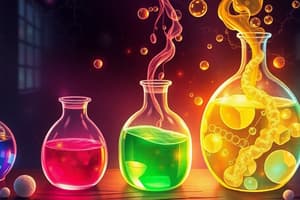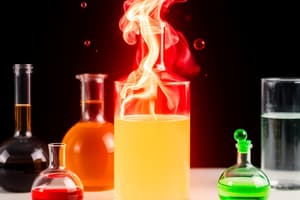Podcast
Questions and Answers
What is formed at the end of a chemical reaction?
What is formed at the end of a chemical reaction?
- Chemical bonds
- Reactants
- Catalysts
- Products (correct)
Chemical reactions can occur just by mixing solid substances together.
Chemical reactions can occur just by mixing solid substances together.
False (B)
Name one condition necessary for a chemical change.
Name one condition necessary for a chemical change.
Close contact, solution, heat, light, electricity, pressure, or catalyst.
A positive catalyst ______ a reaction.
A positive catalyst ______ a reaction.
Which of the following substances reacts explosively when in close physical contact?
Which of the following substances reacts explosively when in close physical contact?
Match the following conditions with their descriptions:
Match the following conditions with their descriptions:
Electric current can facilitate the decomposition of certain compounds.
Electric current can facilitate the decomposition of certain compounds.
What is the role of a catalyst in a chemical reaction?
What is the role of a catalyst in a chemical reaction?
What is the primary effect of sound energy on a reaction?
What is the primary effect of sound energy on a reaction?
In a chemical reaction, gas evolution is not a possible characteristic.
In a chemical reaction, gas evolution is not a possible characteristic.
Give an example of a chemical reaction that results in a colour change.
Give an example of a chemical reaction that results in a colour change.
A precipitate is an _______ solid substance formed in a chemical reaction.
A precipitate is an _______ solid substance formed in a chemical reaction.
Match the following types of chemical reactions with their descriptions:
Match the following types of chemical reactions with their descriptions:
Which of the following is a characteristic of a decomposition reaction?
Which of the following is a characteristic of a decomposition reaction?
A chemical reaction can only result in the formation of gases.
A chemical reaction can only result in the formation of gases.
What happens during a direct combination reaction?
What happens during a direct combination reaction?
What gas is produced alongside two volumes of hydrogen gas during the electrolysis of acidulated water?
What gas is produced alongside two volumes of hydrogen gas during the electrolysis of acidulated water?
A decomposition reaction can only break compounds into elements.
A decomposition reaction can only break compounds into elements.
What is produced when metal bicarbonates decompose?
What is produced when metal bicarbonates decompose?
The thermal decomposition of potassium chlorate produces potassium chloride and _____ gas.
The thermal decomposition of potassium chlorate produces potassium chloride and _____ gas.
Match the following decomposition reactions with their products:
Match the following decomposition reactions with their products:
Which of the following describes a reversible reaction?
Which of the following describes a reversible reaction?
Thermal dissociation is a reaction that occurs only in one direction.
Thermal dissociation is a reaction that occurs only in one direction.
Which compound is formed from the thermal decomposition of calcium carbonate?
Which compound is formed from the thermal decomposition of calcium carbonate?
What type of reaction occurs when zinc displaces copper in copper sulphate?
What type of reaction occurs when zinc displaces copper in copper sulphate?
A neutralization reaction results in the formation of a salt and a base.
A neutralization reaction results in the formation of a salt and a base.
What is formed when an acid reacts with a base?
What is formed when an acid reacts with a base?
The insoluble solid formed during a double displacement reaction is called a __________.
The insoluble solid formed during a double displacement reaction is called a __________.
Match the following acids and bases with their uses in neutralization:
Match the following acids and bases with their uses in neutralization:
Which of the following describes a double displacement reaction?
Which of the following describes a double displacement reaction?
Hydrolysis of a salt formed from a strong base and a weak acid results in an acidic solution.
Hydrolysis of a salt formed from a strong base and a weak acid results in an acidic solution.
What component is produced from the hydrolysis of a strong acid and weak base?
What component is produced from the hydrolysis of a strong acid and weak base?
Flashcards
Chemical Reaction
Chemical Reaction
A process where chemical bonds in reactants are broken and new bonds are formed to create products. It involves rearranging atoms.
Chemical Bond
Chemical Bond
The force that holds atoms together in a molecule. It's like a strong glue binding them.
Close Physical Contact
Close Physical Contact
Two substances must be very close together for a chemical reaction to occur. This allows the atoms to collide and interact.
Solution
Solution
Signup and view all the flashcards
Heat
Heat
Signup and view all the flashcards
Light
Light
Signup and view all the flashcards
Electricity
Electricity
Signup and view all the flashcards
Catalyst
Catalyst
Signup and view all the flashcards
Reversible reaction
Reversible reaction
Signup and view all the flashcards
Thermal dissociation
Thermal dissociation
Signup and view all the flashcards
Thermal decomposition
Thermal decomposition
Signup and view all the flashcards
Decomposition reaction
Decomposition reaction
Signup and view all the flashcards
Electrolysis of acidulated water
Electrolysis of acidulated water
Signup and view all the flashcards
Thermal decomposition of metal bicarbonates
Thermal decomposition of metal bicarbonates
Signup and view all the flashcards
Thermal decomposition of metal carbonates
Thermal decomposition of metal carbonates
Signup and view all the flashcards
Thermal decomposition of metal hydroxides
Thermal decomposition of metal hydroxides
Signup and view all the flashcards
What is a negative catalyst?
What is a negative catalyst?
Signup and view all the flashcards
How can sound energy influence chemical reactions?
How can sound energy influence chemical reactions?
Signup and view all the flashcards
Describe a direct combination reaction.
Describe a direct combination reaction.
Signup and view all the flashcards
What is a decomposition reaction?
What is a decomposition reaction?
Signup and view all the flashcards
What is a sign of a chemical reaction?
What is a sign of a chemical reaction?
Signup and view all the flashcards
What is a key indicator of a chemical reaction?
What is a key indicator of a chemical reaction?
Signup and view all the flashcards
When can precipitation occur during a reaction?
When can precipitation occur during a reaction?
Signup and view all the flashcards
Can phase changes be observed during reactions?
Can phase changes be observed during reactions?
Signup and view all the flashcards
Displacement reaction
Displacement reaction
Signup and view all the flashcards
Double displacement reaction
Double displacement reaction
Signup and view all the flashcards
Precipitation reaction
Precipitation reaction
Signup and view all the flashcards
Neutralization reaction
Neutralization reaction
Signup and view all the flashcards
Hydrolysis
Hydrolysis
Signup and view all the flashcards
Precipitate
Precipitate
Signup and view all the flashcards
Neutralization
Neutralization
Signup and view all the flashcards
Study Notes
Chemical Changes and Reactions
- A chemical reaction involves breaking bonds in reactants and forming new bonds in products.
- A chemical bond holds atoms together in a molecule or compound.
Conditions Necessary for a Chemical Change
- Close Physical Contact (Mixing): Reactions can occur when solids are mixed, such as iodine and sulfur exploding when mixed.
- Solution: Reactions can also occur when substances are mixed in solution, like sodium carbonate and tartaric acid.
- Heat: Some reactions require heat to proceed. For example, copper(II) carbonate decomposes into copper(II) oxide and carbon dioxide when heated.
- Light: Photochemical reactions occur with light energy. Photosynthesis is an example, where carbon dioxide and water react to form glucose and oxygen with sunlight.
- Electricity: Some reactions happen only when electric current passes through the substance. Water decomposes into hydrogen and oxygen gas when electrolyzed.
- Pressure: High pressure is sometimes required for a reaction to occur.
- Catalyst: A catalyst speeds up or slows down a reaction without being consumed. A catalyst works by changing the reaction rate.
Characteristics of a Chemical Reaction
- Evolution of Gas: A gas is produced as a product in some reactions.
- Change of Colour: A change in colour might indicate a reaction.
- Formation of Precipitate: An insoluble solid that forms is called a precipitate.
- Change of State: A change in the phase of matter (solid, liquid or gas) from reactant to product
Types of Chemical Changes/Reactions (Direct Combination/Synthesis)
- Forming a single product from two or more reactants
- Combination of two elements: Two iron atoms and one sulfur atom combine to form iron sulfide.
- Combination of an element and compound: Two carbon monoxide molecules and one oxygen molecule combine to form two carbon dioxide molecules.
- Combination of two or more compounds: Lead(II) oxide and sulfur dioxide react to form lead(II) sulfate.
Types of Chemical Changes/Reactions (Decomposition)
- A single compound breaks down into two or more simpler substances.
- Decomposition by heat: Mercuric oxide breaks down into mercury and oxygen gas when heated.
- Decomposition by electricity: Water breaks down into hydrogen and oxygen gas when an electric current is passed through it.
Thermal decomposition of metal compounds
- Metal hydroxides are generally stable to heat but decompose when heated to a given temperature to give metal oxide and water.
- Metal carbonates decompose when heated to form metal oxide and carbon dioxide.
Types of Chemical Changes/Reactions (Other types)
- Metal bicarbonates/hydrogen carbonates: These decompose to give metal carbonate, water, and carbon dioxide.
- Metal Nitrates: When heated, these decompose, forming a different metal oxide, nitrogen dioxide, and often some oxygen.
Reversible Reactions
- A reversible reaction can proceed in either direction, and the conditions can change the direction.
Displacement Reactions
- A more reactive element displaces a less reactive element in a compound.
- Zinc displaces copper in copper sulfate.
Double Displacement Reactions
- A reaction where ions from two compounds exchange places to form two new compounds.
- Sodium hydroxide and hydrochloric acid produce sodium chloride and water.
Double Decomposition/Metathesis
- A type of reaction where two compounds in a solution react to form two new compounds by the exchange of radicals. These reactions might form a precipitate.
Neutralisation Reactions
- A reaction between an acid and a base that produces a salt and water.
- NaOH + HCl → NaCl + H2O(This is a neutralization reaction).
Hydrolysis
- A reaction where a salt reacts with water, forming an acidic or basic solution. Different combinations of solutions will form solutions with different pH levels.
Energy Changes in Chemical Reactions
- Exothermic: Reactions that release heat.
- Endothermic: Reactions that absorb heat.
Photochemical Reactions
- Reactions that proceed with light energy absorption.
Electrochemical Reactions
- Reactions that proceed with the absorption of electricity.
Studying That Suits You
Use AI to generate personalized quizzes and flashcards to suit your learning preferences.





